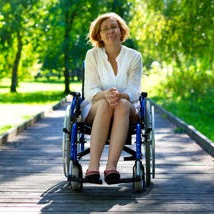 There are a wide variety of adult neurologic conditions ranging from stroke to traumatic brain injury, as well as neurologic diseases like Parkinson’s and Multiple Sclerosis. The resulting challenges vary—from inability to walk or need to use a cane or walker, to not being able to drive, to have challenges with reading—the list is endless.
There are a wide variety of adult neurologic conditions ranging from stroke to traumatic brain injury, as well as neurologic diseases like Parkinson’s and Multiple Sclerosis. The resulting challenges vary—from inability to walk or need to use a cane or walker, to not being able to drive, to have challenges with reading—the list is endless.
If you are affected by one of these conditions, or are the loved one of someone who is, a consuming question probably is, “what type of recovery is possible?” Or the more specific, “will I/they ever walk without this cane, drive again, etc?” The only answer I can give here is that there is a lot of variability.
That said, what I do know is that the brain is “plastic” at any age and in any condition. What that means is that the brain will change at any age and in any condition based on the input it receives. This change or plasticity can be either a path toward improvement or decline. With skilled intervention things could get a whole lot better. Even in the case of progressive degenerative neuromuscular diseases like ALS improved quality of life is possible.
Stories about recovery from brain injures abound. Recently at the Anat Baniel Methodsm conference I was privileged to hear Jill Bolte Taylor speak. She is a big supporter of Anat’s work, the kind of work I do. She is a brain scientist who had a severe stroke. In this well-known TED talk she describes her recovery.
What I was unaware of until the conference is the amazing stained glass and sculptural artwork she does now. Her life is not identical to before her stroke, but in many ways it is better. As a knitter I also know that knitwear designer Kate Davies was a stressed out academic and emerged from her stroke with new focus and success beyond her significant physical recovery.
Norman Doidge, MD tells many stories of recovery in one of his books, The Brain that Changes Itself, and the Brain’s Way of Healing.
One of the many ways to describe the work that I do is “applied neuroplasticity”. Anat Baniel has made a huge contribution in articulating “Nine Essentials” that promote positive change in the brain. Dr. Michael Merzenich, an esteemed neuroscientist who spoke at the same conference said, that though coming at it in very different ways, he and Anat had discovered the same principles.
When I work with my clients with neurologic conditions I always use these “essentials” such as paying attention to the feeling of the movement, slowing down, variation and flexible goals informing what I do.
Variation can prove especially dramatic when working with someone who has Parkinson’s disease, usually (somewhat simplistically) considered as affecting routine movements more than unusual ones. PD symptoms can be variable. I remember one day a man with that disease came into my office unable to walk without flailing around and barely catching himself before he fell. Within an hour of gentle hands on and active movement with attention and lots of variation he walked out normally. Did I cure the Parkinson’s? Clearly not. Will he walk well forever on? Probably not. Still that was a very good day.
Just as if I were working with a developmentally delayed child, I look for what pieces of the larger action may be missing as result of the condition and work to fill in those gaps.
Especially in the presence of cognitive problems, specific brain training activities can also be very helpful. Posit Science, a company partially owned by Dr. Merzenich offers some and does research in this area. Arrowsmith Education, though mostly focusing on “learning disabled” children, has adult programs that invite students who have had brain injuries.
If you or someone you love has a neurologic condition and you found this interesting, I would love to speak with you. Please give me a call at 206-842-4608.
